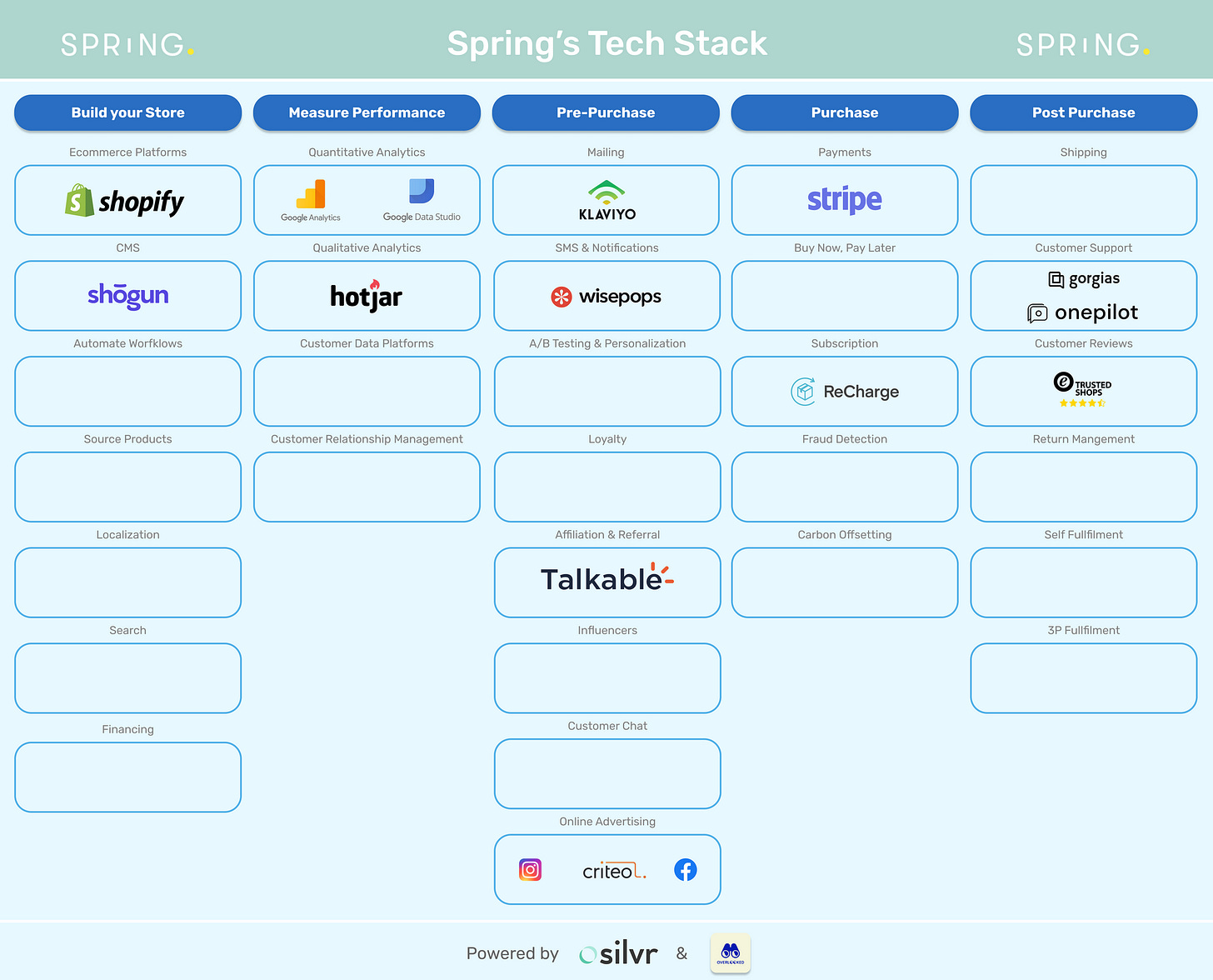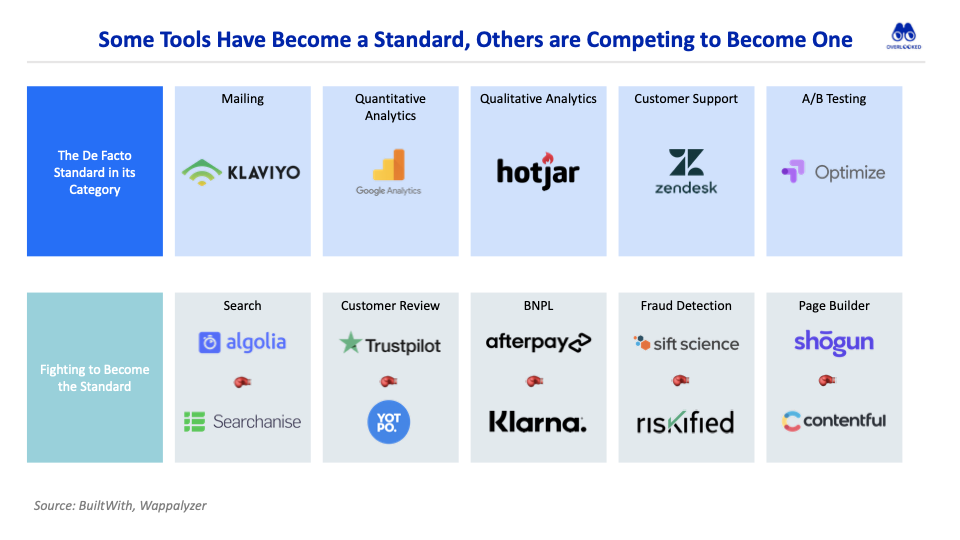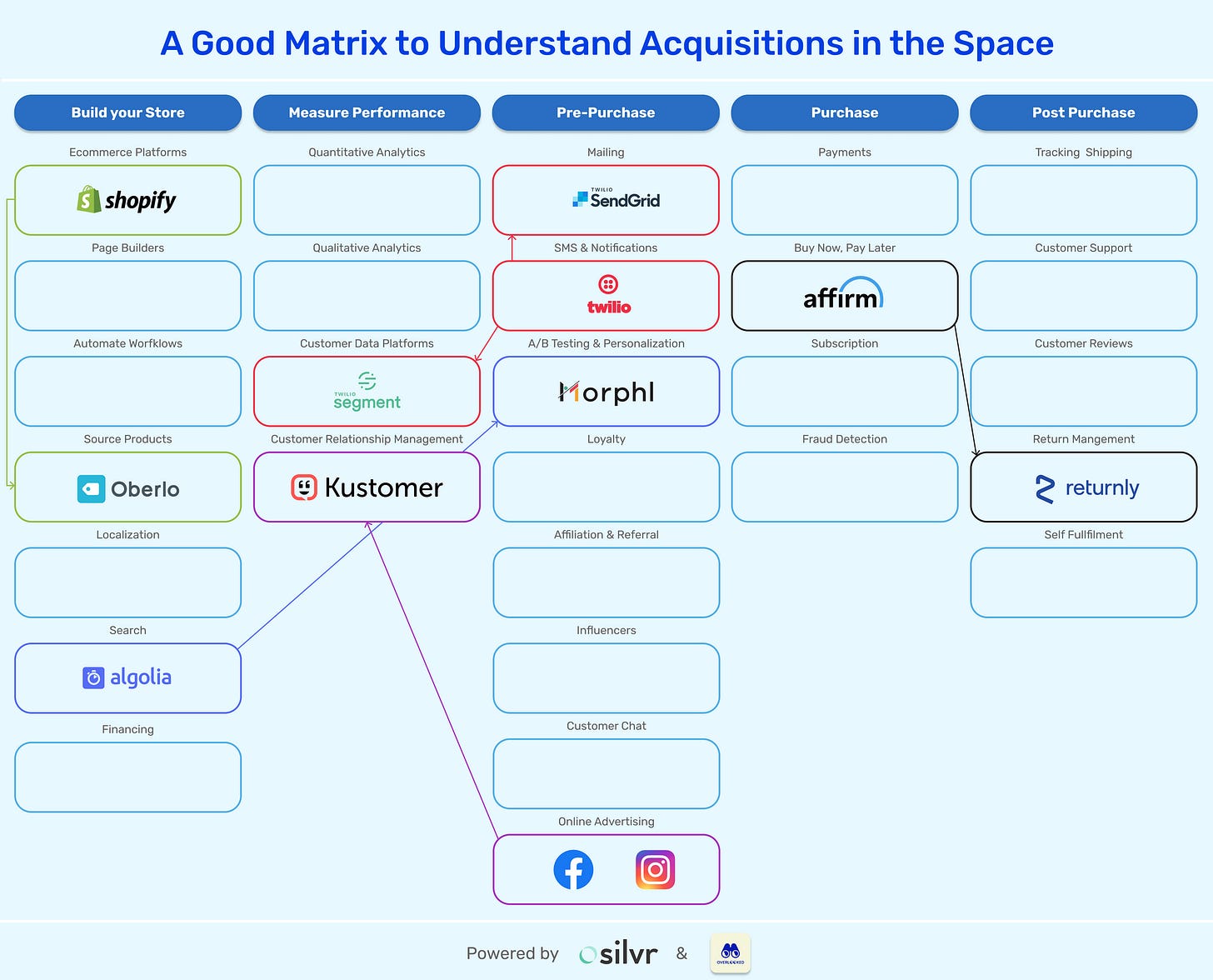Hi, it’s Alexandre from Eurazeo (ex. Idinvest). I’m investing in seed and series A in consumer and consumer enablers startups all over Europe. Overlooked is a weekly newsletter about underrated trends in the European tech industry. Today, I’m sharing a deep-dive on Shopify’s merchants infrastructure stack.
In the next 4 weeks, I'll be working on a deep-dive on the e-commerce infrastructure market. In the past 12m, e-commerce sales went off the chart driven by the pandemic and I noticed a resurgence of entrepreneurs working to reinvent ecommerce's rails. I will publish several papers on the topic to share my progress along the way. If you are an e-commerce merchant or an entrepreneur building a tool for the e-commerce industry, please do send me an email at adewez@eurazeo.com. I would love to have a chat.
I'll work on this deep-dive in partnership with Silvr. It's a revenue based financing solution for e-commerce merchants to finance their online marketing budget. It's a flexible and non dilutive financing instrument. You can get the cash in the bank in 72 hours and you pay back by giving a percentage of your revenues to Silvr until the financing line and the interests are fully reimbursed.
To make the first iteration of this deep-dive, I focused on the Shopify’s merchants infrastructure stack. I've dug into the e-commerce tool-stack of 100+ Shopify's merchants using Wappalyzer and Builtwith, tools to identify the technologies used by a given website. Wappalyzer "inspects HTML, scripts, cookies and network requests and certificates of pages you visit, looking for unique technology fingerprints" while Builtwith “tracks signals that websites are using a particular technology”. I've also dug into the 5.8k applications listed on the Shopify's marketplace. It's obviously a fragmented view of the e-commerce infrastructure market but it's a good starting point.
Introducing the Mapping
Shopify has reshaped the ecommerce toolstack by removing two key friction points associated with starting an ecommerce website:
It has brought down the cost to start an ecommerce website to zero and made the infrastructure costs to run it variable based on your size.
It has removed the need to have a technical team to launch and run an ecommerce website.
I crafted a mapping dividing the e-commerce infrastructure stack into 5 different sections:
Build your store: tools used by merchants to set up a digital store.
Measure performance: tracking tools to gather data on your customers and on the usage of your website.
Pre-purchase: any tool used to drive potentially new and existing customers to your website.
Purchase: tools used during the checkout process - mainly related to payment.
Post-purchase: once the purchase is completed, the merchant will use tools to make sure that the customer has a good shipping and 1st-use experience.
You can find the detailed Airtable clicking on the button below with all the tools used by the 100+ Shopify-powered merchants. I also included a snapshot below for the 15 shops with the largest toolstack.
To give you a more realistic view of the average tech stack, I detailed the tech stack of two French merchants: Panda Tea (wellness teas and infusions) and Spring (home care products delivered through subscription in your mailbox). As you can see, they don't have a tool for each sub-category. You have core subcategories like quantitative analytics, mailing, payment, reviews and customer support for which all merchants have a tool. And you have other subcategories that will be used or not depending on the merchant size, tech maturity and business specificities.
Trend n°1 - Some solutions have become standards when you launch and run an ecommerce website. Others are competing to become a standard in their category.
When I analysed the data collected on 100 Shopify-powered merchants, I discovered that 25 tools were used by 10+ merchants.
We can break down these most-used tools into two categories:
Standard tools in their category (i.e. you pick the tool automatically when you build and grow your Shopify store): Google Analytics (quantitative analytics), Google Optimize (A/B testing), Klaviyo (mailing), Hotjar (qualitative analytics) and Zendesk (customer support).
Tools that are fighting to become the standard in their category: Afterpay vs. Klarna (BNPL), Attentive vs. Privy (SMS marketing), Trustpilot vs. Yotpo (customer reviews), Algolia vs. Searchanise (search), Sift Science vs. Riskifield (fraud detection).
Trend n°2 - The e-commerce market is large enough to build verticalized solutions
Shopify has created an ecosystem of applications plugged to its ecommerce platform through APIs. Shopify is so successful that some of these applications built on top of its platform like Klaviyo and Recharge are now worth billions ($4bn and $2bn respectively).
You can build a billion-dollar business piggybacking Shopify and becoming the de facto standard for Shopify's merchants in a certain category. More broadly, these businesses also validate that the e-commerce market is large enough for verticalized solutions.
Building an e-commerce first solution gives you unfair advantages compared to generalist solutions because you can custom your product and your go to market for e-commerce. Klaviyo in the mailing sub-category and Gorgias in the customer support sub-category are two perfect examples of e-commerce verticalized solutions. They can both outcompete generalist solutions and become the standard for e-commerce merchants. We saw the same trend while digging into the toolstack for app builders.
Trend n°3 - Bootstrapped companies & micro-SaaS conglomerates are also thriving in the Shopify's ecosytem
I discovered several product studios building multiple micro-SaaS sold on the Shopify's marketplace.
HulkApps (2012, Chicago-based, 80 FTEs, 250k customers, 1k websites built): it's a development agency for Shopify's stores which has partly productised its activity by releasing apps and themes that can be purchased through self service. I imagine that these modules (some of them are free) are also a great lead generation machine for the agency.
Bold Commerce (2013, Canada): it offers three key products which are a headless checkout solution, an API to build a subscription and a pricing management platform. Bold also has a myriad of small apps that are available on the Shopify's store that are used as a lead generation channel.
Bootstrap Heroes (2013, Los-Angeles based): it was also a development company working in the Shopify ecosystem. In 2014, they built a spin-off to start Recharge which is now the leading subscription payments platform on Shopify used by more than 10k businesses and now valued over $2bn.
Regarding bootstrapped businesses, Weglot is a great illustration. It's a translation management solution used by 50k merchants. Weglot has built a $7m ARR bootstrapped company on the back of B2B App Stores and Shopify was one of their most successful acquisition channel. 30% of their leads are coming from a B2B App Store.
Trend n°4 - Major players in the e-commerce infrastructure tooling market have a platform strategy
E-commerce giants are constantly adding new tools on their platform to become the one-stop shop for their merchants. When they want to add a tool to their platform, major players can (i) partner with other providers, (ii) build the tool in-house or (iii) acquire an existing player.
Shopify is the paramount illustration of the platform strategy:
It partners with other providers through a marketplace with 5.8k applications listed. Shopify has also a deeper partnership with Stripe that is giving its payment solution in white-label for Shop Pay.
Shopify has built in-house tools for the pre-puchase, purchase and post-purchase experiences with 29 proprietary apps on the marketplace: an emailing tool, a product review tool, a chat tool, a delivery tool, a tool to offset carbon emissions in the checkout etc.
It has also acquired companies to extend its capabilities. In 2017, it acquired Oberlo for $15m. It was an app on the Shopify marketplace for drop-shippers building virtual ecommerce websites. Drop-shippers do not directly manufacture their product, they sell products imported directly from Chinese ecommerce platform AliExpress. In 2019, Shopify also acquired Handshake to integrate a wholesale offering in its value proposition.
I believe that my mapping's breakdown is a good way to rationalize recent acquisitions in the space like the Affirm's acquisition of Returnly for $300m (from purchase with BNPL to post purchase with return management) or the Facebook's acquisition of Kustomer for $1bn (from pre-purchase with online advertising to measure performance with CRM). Another good example is Twilio which acquired Sendgrid and Segment in the past few years to combine their initial marketing messaging capabilities with Sendgrid's mailing product and with Segment's customer data platform. It allows Twilio to come to enterprise customers with a strong and differentiated value proposition. Segment is also a great acquisition to become a system of records for their customers on which you can add verticalized services like mailing, notifications and SMS that are either built by Twilio or by third parties.
Trend n°5 - A platform's risk for tools in the Shopify's ecoystem
With a centralized platform, there is always a misalignment risk between the platform and its stakeholders - in Shopify’s case between Shopify and applications on the Shopify’s marketplace.

Honestly, I believe that, in general, Shopify is doing a much better job than many other platforms at remaining an open ecosystem. It’s true that Shopify has its own set of tools that seem to compete directly with existing solutions on its marketplace. Shopify Mail is competing with Klaviyo. Shopify Flow is competing with Zapier. Shop Pay Installment is competing with Klarna and Afterpay etc. But, Shopify’s internal adjacent tools philosophy is more to offer the basics to merchants than to expand into new categories.
Nonetheless, I think that there are adjacent categories that Shopify wants to own over the long run (checkout, financing, product sourcing and shipping) and we are starting to see more constraints for applications operating in these categories. Zipify is a good illustration of this platform risk. It's a one-click post purchase up-sell application. Merchants integrate Zipify into their Shopify. After having paid for their cart through the Shopify's payment flow, customers are offered the possibility to add and pay in the same click an additional item. Zipify was working independently from the Shopify's checkout flow (i.e. Shopify was not taking a cut of the upsell transaction). Shopify decided that the solution should be natively integrated to its flow to be able to process the payment. As a result, Zipify is no longer available in all the countries in which Shopify's checkout page is not sufficiently mature to have Shop Pay and natively integrated third party apps.
Thanks to Julia (🦒 ), Alex (🐼) and Nima for the feedback! Thanks for reading! See you next week for another issue! 👋














This is SOOOO good Alexandra!!! Would you consider doing an update now in 2024 with all the consolidation in recent years and new trend of AI in commerce?